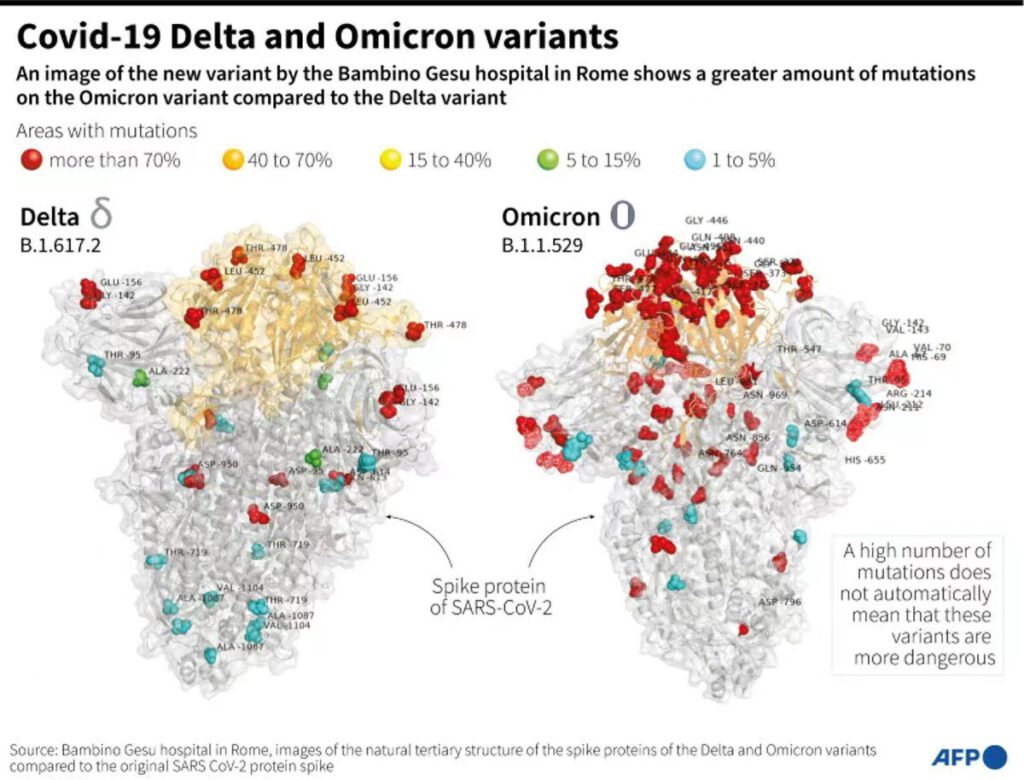
Discovery and prevalence
On 9 November 2021, a variant of coronavirus B.1.1.529 was detected for the first time in South Africa from case samples. On 26 November, the WHO defined it as the fifth variant of concern (VOC), named Omicron. On 27 November, an Italian research team of the Bambino Gesù Hospital in Rome released the world’s first image of Omicron, showing that Omicron has more stinging protein mutations than Delta. These mutations are diverse and mostly located in areas that interact with human cells.
As of 28 November, imports of this variant have been monitored in South Africa, Israel, Belgium, Italy, the United Kingdom, Austria, and Hong Kong of China. The fact that the Omicron was first identified and reported in South Africa does not mean that the virus evolved in South Africa, and the place of discovery of the variant is not necessarily the place of origin.
Possible reasons for its emergence
According to the information currently shared by GISAID, a database that provides open-access to genomic data of influenza viruses and the coronavirus responsible for the COVID-19 pandemic, the number of mutations in the Omicron variant is significantly higher than in all new coronavirus variants that have been circulating in the last two years, especially in the spike protein.

Three possible reasons for their occurrence are postulated.
(1) Following infection with a neo-coronavirus in an immunodeficient patient, a large number of mutations accumulated in the body over an extended period of evolution and transmitted by chance.
(2) An animal population is infected with the coronavirus and the virus evolves adaptively during transmission in the animal population, mutating at a higher rate than in humans, and subsequently spilling over to infect humans.
(3) The mutant strain persists for a long time in countries or regions where monitoring of genomic variation in the coronavirus is poor and intermediate generations of the evolved virus are not detected in time due to inadequate monitoring capacity.
Transmissibility of Omicron mutant strains
According to Russia Today (RT), Omicron is currently spreading at an alarming rate across Africa and beyond. In South Africa, for example, 90% of new infections in Gauteng have recently been linked to this mutant strain. The Omicron variant is considered by many Western media to be the most dangerous coronavirus variant in existence worldwide.
Till now, there are no systematic studies on the transmission, pathogenicity, and immune escape capacity of the Omicron variant worldwide. However, the Omicron variant shares important amino acid mutation sites in the first four VOC variants: Alpha, Beta, Gamma, and Delta, including mutations that enhance cellular receptor affinity and viral replication.
The Delta mutant strain, discovered in India last October, contains a total of 15 mutations and was classified as a VOC by the WHO in May this year, while Omicron, also classified as a VOC by the WHO, carries at least 32 mutations. A large number of mutations means that it could weaken the effectiveness of existing COVID-19 vaccines and could be more infectious.
Impact on vaccines, antibody drugs, and nucleic acid testing
Studies have shown that the presence of the K417N, E484A, or N501Y mutations in the S protein of the coronavirus is indicative of increased immune escape, while the Omicron variant has a triple mutation (“K417N+E484A+N501Y”). In addition, the Omicron variant has several other mutations that may reduce some of the neutralizing activity of some of the monoclonal antibodies. WHO officials said little is known about the new mutant strain and more experimental data is needed to assess whether it is more infectious or more resistant to the vaccine.
Genomic analysis of the Omicron variant has shown that the mutated loci do not affect the sensitivity and specificity of the main nucleic acid detection reagents mainly produced in China and widely used in different countries. The mutated loci of the Omicron variant are mainly in the highly variable region of the S protein gene and are not located in the target regions of primers and probes for nucleic acid detection reagents of China. However, data from several laboratories in South Africa suggest that the S gene of the Omicron variant may not be effectively detected for nucleic acid test reagents that target the S gene.
Measures taken and WHO’s recommendations
Given the rapid prevalence of the Omicron variant in South Africa, several countries and regions, including the USA, UK, the EU, Russia, Israel, Taiwan of China, and Hong Kong of China, have restricted entry of travelers from southern Africa.
WHO recommends that countries strengthen surveillance, reporting, and research on the coronavirus and take effective public health measures to interrupt the spread of the virus. Effective infection prevention measures recommended for individuals include keeping a distance of at least one meter in public places, wearing a mask, opening windows for ventilation, keeping hands clean, coughing or sneezing into tissues, taking vaccination, and avoiding poorly ventilated or crowded places. It is uncertain whether the Omicron variant is more transmissible, pathogenic, and immune escape than other VOC variants, and preliminary results from related studies will be available in the next few weeks.
What is known, however, is that all variant strains can cause severe illness or death, so prevention of virus transmission is always key and the COVID-19 vaccine remains effective in reducing severe illness and death.
(Source: AFP, WHO, RT, cnbctv18)



